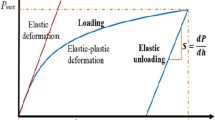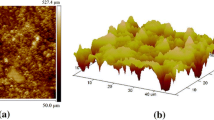Abstract
In this study, we propose an energy-based method to extract the nanomechanical properties such as indentation modulus and hardness for cementitious materials within the framework of contact mechanics that relies on more accurate and realistic interpretation of the load–displacement data. Such interpretation allows us to evaluate both the initial unloading stiffness and the hardness—two main input parameters for the Sneddon’s solution to indentation of an elastic half-space—directly as the functions of indentation works. Specifically, we show that while the initial unloading stiffness may be expressed in terms of normalized elastic work, the hardness may be evaluated from the total work done using the modified work-of-indentation approach. Results from nanoindentation on hardened cement paste show that the proposed energy-based method provides the indentation modulus and the hardness in agreement with the Oliver and Pharr method for all the nanomechanical phases of the paste considered. Two main advantages associated with the proposed method include: it circumvents the need of fitting the unloading response by a power-law and computing the area of contact between indenter and specimen. As the method described herein is simple and easy to use, it could be employed as a potential alternative to the conventional Oliver and Pharr method for a heterogeneous material like cement paste.









Similar content being viewed by others
References
Bernard O, Ulm F-J, Lemarchand E (2003) A multiscale micromechanics-hydration model for the early-age elastic properties of cement based materials. Cem Concr Res 33(9):1293–1309
Constantinides G, Ulm F-J (2004) The effect of two types of C-S-H on the elasticity of cement-based materials: results from nanoindentation and micromechanical modeling. Cem Concr Res 34(1):67–80
Oliver WC, Pharr GM (1992) An improved technique for determining hardness and elastic modulus using load and displacement sensing indentation experiments. J Mater Res 7(6):1564–1583
Oliver WC, Pharr GM (2004) Measurement of hardness and elastic modulus by instrumented indentations: advances in understanding and refinements to methodology. J Mater Res 19(1):3–20
Doerner MF, Nix WD (1986) A method for interpreting the data from depth-sensing indentation instruments. J Mater Res 1(4):601–609
Sneddon IN (1965) The relation between load and penetration in the axisymmetric Boussinesq problem for a punch of arbitrary profile. Int J Eng Sci 3(1):47–57
Oliver WC (2001) Alternative technique for analyzing instrumented indentation data. J Mater Res 16(11):3202–3206
Velez K, Maximilien S, Damidot D, Fantozzi G, Sorrentino F (2001) Determination by nanoindentation of elastic modulus and hardness of pure constituents of Portland cement clinker. Cem Concr Res 31(4):555–561
Sarris E, Constantinides G (2013) Finite element modeling of nanoindentation on C-S-H: effect of pile-up and contact friction. Cem Concr Compos 36:78–84
Pharr GM (1998) Measurement of mechanical properties by ultra-low load indentation. Mater Sci Eng A 253(1–2):151–159
Constantinides G, Ulm F-J (2003) On the use of nanoindentation for cementitious materials. Mater Struct 36(3):191–196
Konsta-Gdoutos MS, Metaxa ZS, Shah SP (2010) Highly dispersed carbon nanotube reinforced cement based materials. Cem Concr Res 40(7):1052–1059
Abu Al-Rub RK, Tyson BM, Yazdanbakhsh A, Grasley Z (2012) Mechanical properties of nanocomposites cement incorporating surface-treated and untreated carbon nanotubes and carbon nanofibres. J Nanomech Micromech ASCE 2(1):1–6
Cheng YT, Cheng CM (1998) Relationships between hardness, elastic modulus and the work of indentation. Appl Phys Lett 73(5):614–616
Dao M, Chollacoop N, Van Vliet KJ, Venkatesh TA, Suresh S (2001) Computational modeling of the forward and reverse problems in instrumented sharp indentation. Acta Mater 49(19):3899–3918
Tho KK, Swaddiwudhipong S, Liu ZS, Zeng K, Hua J (2004) Uniqueness of reverse analysis from conical indentation tests. J Mater Res 19(8):2498–2502
Alkorta J, Martinez-Esnaola JM, Gil Sevillano J (2005) Absence of one-to-one correspondence between elastoplastic properties and sharp-indentation load-penetration data. J Mater Res 20(2):432–437
Malzbender J (2005) Comment on the determination of mechanical properties from the energy dissipated during indentation. J Mater Res 20(5):1090–1092
Chen J, Bull SJ (2009) Relation between the ratio of elastic work to the total work of indentation and the ratio of hardness to Young’s modulus for a perfect conical tip. J Mater Res 24(3):590–598
Hainsworth SV, Chandler HW, Page TF (1996) Analysis of nanoindentation load-displacement loading curves. J Mater Res 11(8):1987–1995
Jha KK, Suksawang N, Agarwal A (2010) Analytical method for the determination of indenter constants used in the analysis of nanoindentation loading curves. Scripta Mater 63(3):281–284
Malzbender J, de With G, den Toonder J (2000) The P–h2 relationship in indentation. J Mater Res 15(5):1209–1212
Stilwell NA, Tabor D (1961) Elastic recovery of conical indentations. Phys Proc Soc Lond 78(2):169–179
Tuck JR, Korsunsky AM, Davidson RI, Bull SJ, Elliott DM (2000) Modeling of the hardness of electroplated nickel coatings on copper substrate. Surf Coat Technol 127(1):1–8
Zhou L, Yao Y (2007) Single crystal bulk material micro/nano indentation hardness testing by nanoindentation instrument and AFM. Mater Sci Eng A 460–461:95–110
Gong J, Miao H, Peng Z (2004) Analysis of the nanoindentation data measured with a Berkovich indenter for brittle materials: effect of the residual contact stress. Acta Mater 52(3):785–793
Jha KK, Suksawang N, Lahiri D, Agarwal A (2012) Energy-based analysis of nanoindentation curves for cementitious materials. ACI Mater J 109(1):81–90
Marx V, Blake H (1997) A critical investigation of the unloading behavior of sharp indentation. Acta Mater 45(9):3791–3800
Sawa T, Tanaka K (2001) Simplified method for analyzing nanoindentation data and evaluating performance of nanoindentation instruments. J Mater Res 16(11):3084–3096
VanLandingham MR, Villarrubia JS, Guthrie WF, Meyers GF (2001) Nanoindentation of polymers: an overview. Macromol Symp 167:15–45
Tranchida D, Piccarolo S (2005) On the use of the nanoindentation unloading curve to measure Young’s modulus of polymers on nanometer scale. Macromol Rapid Commun 26(22):1800–1804
Jha KK (2012) An energy-based nanomechanical properties evaluation method for cementitious materials. PhD Dissertation submitted to Florida International University, Miami
Pharr GM, Oliver WC, Brotzen FR (1992) On the generality of the relationship among contact stiffness, contact area, and elastic modulus during indentation. J Mater Res 7(3):613–617
Hay JC, Bolshakov A, Pharr GM (1999) A critical examination of the fundamental relations used in the analysis of nanoindentation data. J Mater Res 14(6):2296–2305
King RB (1987) Elastic analysis of some punch problems for a layered medium. Int J Solids Struct 23(12):1657–1664
Strader JH, Shim S, Bei H, Oliver WC, Pharr GM (2006) An experimental evaluation of the constant β relating the contact stiffness to the contact area in nanoindentation. Philos Mag 86(33–35):5285–5298
Meza JM, Abbes F, Troyon M (2008) Penetration depth and tip radius dependence on the correction factor in nanoindentation measurement. J Mater Res 23(3):725–731
Xu Z-H, Li X (2008) Effects of indenter geometry and material properties on the correction factor of Sneddon’s relationship for nanoindentation of elastic and elasto-plastic materials. Acta Mater 56(6):1399–1405
Martin M, Troyon M (2002) Fundamental relations used in nanoindentation: critical examination based on experimental measurements. J Mater Res 17(9):2227–2234
Attaf MT (2003) New ceramics related investigation of the indentation energy concept. Mater Lett 57(30):4684–4693
Attaf MT (2003) A unified aspect of power-law correlations for Berkovich hardness testing of ceramics. Mater Lett 57(30):4627–4638
Miller M, Bobko C, Vandamme M, Ulm F-J (2008) Surface roughness criteria for cement paste nanoindentation. Cem Concr Res 38(4):467–476
Mondal P, Shah SP, Marks L (2007) A reliable technique to determine the local mechanical properties at the nanoscale for cementitious materials. Cem Concr Res 37(10):1440–1444
Davydov D, Jirasek M, Kopecky L (2011) Critical aspects of nano-indentation technique in application to hardened cement paste. Cem Concr Res 41(1):20–29
Constantinides G, Ravi Chandran KS, Ulm F-J, Van Vliet KJ (2006) Grid indentation analysis of composite microstructure and mechanics: principles and validation. Mater Sci Eng A 430(1–2):189–202
Constantinides G, Ulm F-J (2007) The nanogranular nature of C-S-H. J Mech Phys Solids 55(1):64–90
Zhu W, Hughes JJ, Bicanic N, Pierce CJ (2007) Nanoindentation mapping of mechanical properties of cement paste and natural rocks. Mater Charact 58(11–12):1189–1198
Mondal P, Shah SP, Marks LD (2008) Nanoscale characterization of cementitious materials. ACI Mater J 105(2):174–179
Vandamme M, Ulm F-J, Fonollosa P (2010) Nanogranular packing of C-S-H at substochiometric conditions. Cem Concr Res 40(1):14–26
Jha KK, Suksawang N, Lahiri D, Agarwal A (2013) Evaluating initial unloading stiffness from elastic work-of-indentation measured in a nanoindentation experiment. J Mater Res 28(6):789–797
Attaf MT (2004) New formulation of the nanomechanical quantities using the β-material concept and the indentation function. Mater Lett 58(6):889–894
Beegan D, Chowdhury S, Laugier MT (2005) Work of indentation methods for determining copper film hardness. Surf Coat Technol 192(1):57–63
Khan MK, Hainsworth SV, Fitzpatrick ME, Edwards L (2009) Application of the work of indentation approach for the characterization of aluminum 2024-T351 and Al cladding by nanoindentation. J Mater Sci 44(4):1006–1015
Cao Y, Xue Z, Chen X, Raabe D (2008) Correlation between the flow stress and the nominal indentation hardness of soft metals. Scripta Mater 59(5):518–521
Ma D, Ong CW, Zhang T (2009) An instrumented indentation method for Young’s modulus measurement with accuracy estimation. Exp Mech 49(5):719–729
Nemecek J (2009) Creep effects in nanoindentation of hydrated phases of cement pastes. Mater Charact 60(9):1028–1034
Acknowledgments
KKJ acknowledges the financial support from the University Graduate School, Florida International University in the form of Dissertation Year Fellowship. The authors would like to acknowledge the support extended by Mr. Neal Ricks, Manager, Advanced Materials Engineering Research Institute (AMERI) at Florida International University in preparing the samples for nanoindentation. Likewise, we would like to acknowledge Ms. Barbara Avila, Territory Manager, Titan America for providing us fresh cement for sample preparation. A.A. acknowledges funding from the Office of Naval Research DURIP program (N00014-06-0675).
Author information
Authors and Affiliations
Corresponding author
Rights and permissions
About this article
Cite this article
Jha, K.K., Suksawang, N., Lahiri, D. et al. A novel energy-based method to evaluate indentation modulus and hardness of cementitious materials from nanoindentation load–displacement data. Mater Struct 48, 2915–2927 (2015). https://doi.org/10.1617/s11527-014-0367-7
Received:
Accepted:
Published:
Issue Date:
DOI: https://doi.org/10.1617/s11527-014-0367-7




